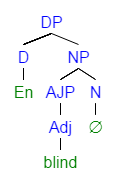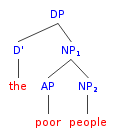Nominalized adjective
| Part of a series on |
| Linguistics |
|---|
|
|
A nominalized adjective is an adjective that has undergone nominalization, and is thus used as a noun. For example, in the rich and the poor, the adjectives rich and poor function as nouns denoting people who are rich and poor respectively.
In English
The most common appearance of the nominalized adjective in English is when an adjective is used to indicate a collective group. This happens in the case where a phrase such as the poor people becomes the poor. The adjective poor is nominalized, and the noun people disappears. Other adjectives commonly used in this way include rich, wealthy, homeless, disabled, blind, deaf, etc., as well as certain demonyms such as English, Welsh, Irish, French, Dutch.
Another case is when an adjective is used to denote a single object with the property, as in "you take the long route, and I'll take the short". Here the short stands for "the short route". A much more common alternative in the modern language is the structure using the prop-word one: "the short one". However, the use of the adjective alone is fairly common in the case of superlatives such as biggest, ordinal numbers such as first, second, etc., and other related words such as next and last.
Many adjectives, though, have undergone conversion so that they can be used regularly as countable nouns; examples include Catholic, Protestant, red (with various meanings), green, etc.
Historical development
Nominal uses of adjectives have been found to have become less common as the language developed from Old English through Middle English to Modern English. The following table shows the frequency of such uses in different stages of the language.[1]
| Period | Early OE (to 950) |
Late OE (950–1150) |
Early ME (1150–1350) |
Late ME (1350–1500) |
1500–1570 | 1570–1640 | 1640–1710 |
| Frequency of adjectives used as nouns (per 100,000 words) |
316.7 | 331.4 | 255.2 | 73.4 | 70.1 | 78.9 | 91.1 |
The decline in the use of adjectives as nouns may be attributed to the loss of adjectival inflection throughout Middle English. In line with the Minimalist Framework elaborated by Noam Chomsky,[2] it is suggested that inflected adjectives are more likely to be nominalized because they have overtly marked φ-features (such as grammatical number and gender), which makes them suitable for use as the complement of a determiner – determiners have unvalued φ-features and thus need to find a complement with a valued φ-feature to meet semantic comprehension.[1] In the diagrams shown below the determiner is the, and its complement is either the noun phrase poor people, or the nominalized adjective poor.
-
Tree diagram of determiner phrase with poor as an attributive adjective
-
Transformed determiner phrase with poor as nominalized adjective
As the frequency of nominalized adjective use decreased, the frequency of structures using the prop-word one increased (phrases such as "the large" were replaced by those of the type "the large one"). In most other languages there is no comparable prop-word, and nominalized adjectives (which in many cases retain inflectional endings) have remained more common.
For more information on the use of adjectives in Old English, see Postpositive adjective (Old English).
In other languages
German
Adjectives in German change their form for various features, such as case and gender, agreeing with the noun they modify. The adjective alt (old), for example, will develop a separate lexical entry that carries the morphological and syntactic requirements of the head noun that has been removed,[3] these requirements being the inflectional endings of the language.
- der Alt-e
- the.NOM.SG.MASC old-NOM.SG.MASC
- 'the old man' (Sadock 1991)
- den Alt-en
- the.ACC.SG.MASC old-ACC.SG.MASC
- 'the old man' (Sadock 1991)
Here der Alte is inflected for masculine gender, singular number and nominative case, meaning the old man.[4] Den Alten is similar but is in the accusative case. The nominalized adjective is derived from the adjective alt, surfacing as it does by taking the appropriate inflection.[3]
Swedish
Similar to English, adjectival nouns are used as a plural definite like in (e.g., the unemployed) and with nationality words (e.g., The Swedish). Contrastively, Swedish does not require "one or ones" when dealing with count nouns (e.g., The old cat is slower than the new (one). Through the use of inflection (incorporating the number and gender of the noun) Swedish is able to evade the need for a visible noun when describing a noun, this phenomenon is also seen when inflecting adjectival nouns.[5]
Standard use of an adjectival noun

A noun phrase with both the noun and the adjective.
| en | blind |
| a.SG.NOM | blind |
| a blind person[5] | |

A noun phrase with only the adjectival noun.
| de | blind-e |
| the.PL.NOM | blind-PL |
| the blind[5] | |
Example of indefinite use
| de | död-a |
| the.PL.NOM | dead-PL |
| the dead[5] | |
Use of number and gender inflection
| det | nya |
| the.N.SG | new[note 1] |
| the new (thing)[5] | |
- ^ Swedish adjectives in definite form do not inflect for gender and number.
| den | gamla |
| the.F. SG | woman |
| the old woman[5] | |
Ancient Greek
Ancient Greek uses nominalized adjectives without a "dummy" or generic noun like English "one(s)" or "thing(s)".[6] In Greek the adjective that is modifying that noun carries information about gender, number and case and is able to remove the noun entirely.
πολλαί
many.FEM.NOM.PL
"many women" (Balme & Lawall 2003) or "many things (of feminine gender)"
καλόν
beautiful.NEUTER.NOM.SG
"a beautiful thing" or "a beautiful one"
τὸ καλόν
the.NEUTER.NOM.SG
"the beautiful thing" or "the beautiful one"
Russian
In Russian, the conversion (or zero derivation) process of an adjective becoming a noun is, in fact, the only type of conversion that is allowed. This process functions as a critical means of addition to the open class category of nouns. Of all the Slavic languages, Russian uses the attributive nouns the most. When the adjective is nominalized, the adjectival inflection alone expresses case, number, and gender, omitting the noun altogether.[7] For example the Russian word приемная комната priyemnaya komnata "receiving room" becomes приемная priyemnaya which means "reception room". The adjective "receiving" takes the nominal from "reception", thus subsuming the noun "room". Many adjectival nouns in Russian serve to create nouns. These common forms of nouns are known as "deleted nouns", of which there are three types. The first subtype of this derivation happens in the specific context of within a sentence or phrase, and refers back to the original noun which it is describing. For example, in the phrase, "the chocolate cakes are better than the vanilla", the adjective "vanilla" has become a noun and is assumed to mean "the vanilla ones". Such a derivation is contextually sensitive to the lexical meaning of the phrase it is a part of. This content specific use of adjectival nouns also happens in the second subtype, in which nouns can be deleted, or assumed, in colloquial expressions. For example, in Russian, one might say "the on-coming" when referring to an on-coming headwind, in which the noun "headwind" is assumed. The third subtype is known as the "permanent" adjectival noun and consists of an adjective that stands alone as a noun. These adjectives have become nouns over the course of history and most speakers are aware of their implicit adjectival meaning.
Arabic
Nominalized adjectives occur frequently in both Classical and Modern Standard Arabic. An example would be الإسلامية al-ʾislāmiyyah "things (that are) Islamic", derived from the adjective إسلامي ʾislāmī "Islamic" in the inanimate plural inflection. A further example would be الكبير al-kabīr "the big one" (said of a person or thing of masculine gender), from كبير kabīr "big" inflected in the masculine singular.
See also
- Collateral adjective
- Noun adjunct, a noun used as an adjective
- Adnoun, alternative term for nominalised adjective, alternative historical term for adjective
References
- ^ a b Yamamura, Shuto (2010). "The Development of Adjectives used as Nouns in the History of English". English Linguistics. 27 (2): 344–363.
- ^ Roger, Martin; Michael, David; Juan, Uriageraka (2000). "Minimalist Inquiries: The Framework," Step by Step: Essays on Minimalist Syntax in Honour of Howard Lasnik. Cambridge: MIT Press.
- ^ a b Sadock, Jerrold M. (1991). Autolexical syntax: A Theory of Parallel Grammatical Representations. Chicago: The University of Chicago Press. p. 41.
- ^ "Adjectival Nouns". Dartmouth.edu. Retrieved 2016-06-19.
- ^ a b c d e f Holmes, Philip; Hinchliffe, Ian (1994). Swedish: A compressive grammar (Second ed.). London and New York: Routledge. pp. 96–102.
{{cite book}}:|access-date=requires|url=(help) - ^ Balme, Maurice; Lawall, Gilbert (2003). Athenaze (second ed.). Oxford University Press. p. 96.
{{cite book}}:|access-date=requires|url=(help) - ^ Swan, Oscar (April 1980). "The Derivation of the Russian Adjectival Noun". Russian Linguistics. 4 (4): 397–404.
{{cite journal}}:|access-date=requires|url=(help)


